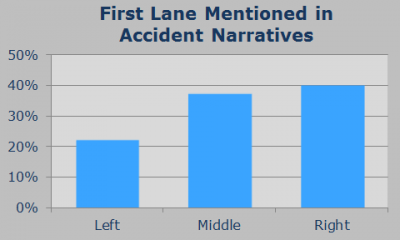Highway Safety: Choosing the Safest Lane, and Other Tips for Staying Safe on the Road


Believe It Or Not, Not All Highway Travel Lanes Are Equally Safe
Ever wondered which lane on the highway is the safest? I wondered this recently as I barreled down road at 65 miles an hour with my child in the car and traffic whizzed past me, some cars going 80. When it comes to highway safety, how can we be safe?
The highways in Southern California are notoriously heart stopping, and I drive them daily with my children, so I wanted to know. And boy was I surprised: It turns out that research points towards the fast lane, or left lane, as the safest.

According DFKOZ.tumblr.com, the left lane has the fewest crashes. However, left lane crashes often cause severe injuries and often death.
Maybe that’s why I don’t like driving in the fast lane. It also feels lawless, and I don’t like being tailgated at 70 miles an hour.
Highway Merges Present Greatest Danger
But merging is not for the faint of heart, which is why the right lane has the highest rate of accidents. People exiting and entering the highway merge and can cause accidents.
The NCBI states this danger quite plainly:
“…semi-truck related crashes, higher number of lanes on freeways, higher number of lanes on ramps, speeding related crashes, and alcohol related crashes tend to increase the likelihood of sustaining severe injuries at freeway merging locations.”
Accident Rates Increase as Economy Bounces Back
According to Consumer Reports, deaths due to car crashes have suddenly spiked.
“After six years of steady declines in motor-vehicle deaths in the U.S., the initial data for 2012 grabbed the attention of many safety advocates when it showed a notable 5 percent spike. That means 1,700 more people died on our roads; the estimated total is 34,080.
What caused the additional deaths isn’t known, and the National Highway Traffic Safety Administration probably won’t have final 2012 data until early next year. But a number of safety experts note an increase in miles driven due to the easing of the recession and 2012’s exceptionally mild winter and spring.
In retrospect, the uptick in deaths shouldn’t have been surprising. “Economic recessions have suppressed traffic fatalities before, notably in the early ’80s and early ’90s,” Kenneth P. Kolosh, statistics manager for the National Safety Council, said. “Fatality numbers tend to bounce up in recovery periods.”
Lovely, news, isn’t it?
Defensive Driving: A Great Way to Prevent Accidents
We all know that people drive faster on highways, but did we know that according to the NHTSA 30% of fatal crashes were due to excessive speed?
Of course you’re not the one driving the excessive speed, it’s the idiot behind/beside/in front of you. Which makes driving defensively a great strategy.
Here are some tips:
- Keep your eyes on the road, hands on the wheel and avoid distractions such as eating, tuning the radio or looking at navigation;
- Make sure to leave plenty of room between you and the car ahead. Use the 2-second rule: pick an object ahead, a light pole or mile marker, and when the car in front of you passes it, count “1 Mississippi, 2 Mississippi;” your car not should pass that object in less than 2 seconds;
- If someone is tailgating you, move to another lane;
- Be aware of the road conditions and maintain a speed that is safe for those conditions;
- Be aware of all the cars around you and keep an eye on them;
- Make yourself visible by using headlights and turn signals;
- Familiarize yourself with the route and road rules before starting your drive;
- Don’t be a hothead. The idiot in front of you won’t hear you yelling at him; you’re just putting yourself and your passengers in danger by reacting to his aggression.
- If highway traffic is too dangerous or frustrating, take another route.
Here’s another good reason to drive defensively: to avoid being part of a pile-up, another hazzard of living in Southern California (as well as other places, too).
According to Wikipedia, “Pile-ups generally occur in low-visibility conditions as drivers on freeways are sometimes caught out by driving too close to the vehicle in front and not adjusting to the road conditions.
Due to the high traffic speeds on the road, if one car develops a problem and suddenly halts, those behind it cannot stop in time and may hit it. Considering that these roads often have high traffic volumes, more cars are forced into braking and skidding, darting into other lanes and in front of oncoming traffic and so more vehicles become involved, creating a chain reaction effect.”
This doesn’t sound like a good way to spend your time. Personally. I have a low tolerance for accepting pile ups as excusable. We need to drive much, much more safely on the freeways.
Don’t Be A Yahoo
I see far too many yahoos driving 80MPH and zig-zagging on a stretch of open highway, so putting my family in the left lane is not in the cards for me. You’ll see me in the middle lane, maybe in the right lane and driving as safely as possible.
I hope that, no matter which lane you choose, you’ll remember each car is filled with beautiful human life and it’s worth your energy and time to focus on the task at hand, arriving safely at your destination.
Original post from Lindsay Kavet
More About:Car Culture
